
Strong biological performance but quiet quarter in the FOF segment
17.02.2025
The Bakkafrost Group delivered a total operational EBIT of DKK 280 million (DKK 356 million) in Q4 2024.
(Figures in parenthesis refer to the same period last year unless otherwise specified)
The performance in Q4 2024 per region was as follows:
- Faroe Islands Revenues of DKK 1,184 million (1,478 million)
Operational EBIT of DKK 310 million (461 million)
- Scotland Revenues of DKK 286 million (84 million)
Operational EBIT of DKK -31 million (-104 million)
Commenting on the result, CEO Regin Jacobsen said:
"The Freshwater and Farming operations in Faroe Islands had a strong development in this quarter. Biological performance remains robust, with solid growth, effective sea lice management, and harvesting of large fish. We are also pleased with the continued progress in our freshwater segment, which has set new production records for the second consecutive quarter of producing large, high-quality smolt. This improved efficiency is helping to reduce costs.
The FOF segment achieved record-high feed sales in 2024, marking the second-best year after 2023. Despite good full-year financial results, fourth-quarter performance was hurt by lower external fishmeal and oil sales due to reduced raw material sourcing, which normalized following the record-high levels in 2023.
In Scotland, the transition to producing large, high-quality smolt at Applecross has begun. As we scale up production this year and gradually replace legacy fish from our marine farms with high-quality fish, we expect a fundamental transformation of our farming operations from next year onwards. Overall, we are pleased with the de-risking of our Scottish operations in 2024. Mortality has decreased significantly, and fish harvested in the quarter was large, contributing to the highest full-year EBITDA since the acquisition. As we await the full replacement of legacy fish, we will continue a similar de-risking strategy in 2025, before starting the journey to ramp up production from 2026.
Stronger supply growth contributes to downward price pressure. The market price for salmon was weaker than expected this quarter, negatively impacting the margin.
Three major projects are progressing well – the Applecross and Skálavík hatcheries and the expansion of Havsbrún feed factory. These projects are crucial to achieving our goals for 2028 and beyond with robust large smolt, best feed and good fish welfare.”
During Q4 2024, the FOF segment sourced 41,919 tonnes (53,552 tonnes) of raw material. The Operational EBIT margin was 12% (25%), and fish feed sales amounted to 38,853 tonnes (39,354 tonnes).
For the full year 2024, the FOF segment’s operational EBIT margin was 18% (23%). For the full year 2024, Havsbrún sourced 309,502 tonnes (467,037 tonnes) of raw material.
In Q4 2024, the Freshwater segments in the Faroe Islands and Scotland transferred a total of 7.1 million (6.8 million) smolts combined:
- Freshwater FO: 6.1 million (5.2 million)
- Freshwater SCT: 1.0 million (1.7 million).
In 2024, the freshwater segments have transferred a total of 23.1 million (23.2) million smolts
- Freshwater FO: 17.1 million (14.2 million)
- Freshwater SCT: 6.0 million (9.0 million).
In Q4 2024, the Freshwater FO segment made an operational EBIT per kg transferred smolt of DKK 43.52 (DKK 26.75), corresponding to NOK 68.59 (NOK 41.78). The Freshwater SCT segment made an operational EBIT per kg transferred smolt of DKK -181.48 (DKK -49.44), corresponding to NOK -286.01 (NOK -77.23).
The Farming segments achieved lower prices in Q4 2024 than in Q4 2023. The Farming segments had higher volumes in Q4 2024 compared to Q4 2023. In Q4 2024, the Farming SCT segment had incident-based costs of DKK 19 million (DKK 48 million).
The total combined harvest in Q4 2024 of the farming segments in the Faroe Islands and Scotland was 20,478 tonnes gutted weight (17,067 tgw):
- Farming FO: 16,638 tgw (16,005 tgw)
- Farming SCT: 3,840 tgw (1,062 tgw).
For the full year 2024, the farming segments have harvested a total of 90,656 tonnes gutted weight (73,006):
- Farming FO: 62,776 tgw (52,408 tgw),
- Farming SCT: 27,880 tgw (20,598 tgw).
In Q4 2024, the Farming FO segment made an operational EBIT per kg of DKK 5.98 (DKK 4.01), corresponding to NOK 9.43 (NOK 6.27). The Farming SCT segment made an operational EBIT per kg of DKK -14.44 (DKK -44.97), corresponding to NOK -22.76 (NOK -70.24).
The Services segment made an operational EBIT per kg of DKK 1.23 (DKK 0.76), corresponding to NOK 1.93 (NOK 1.18). The operational EBIT margin for the segment was 13% (7%).
The Sales & Other segment had a revenue of DKK 2,293 million (2,355 million) and an operational EBIT margin of -5% (4%). The operational EBIT per kg was DKK 5.88 (DKK 5.94), corresponding to NOK 9.26 (NOK 9.27).
The long-term goal of the Board of Directors is that 30-50% of earnings per share shall be paid out as a dividend. Bakkafrost’s financial position is strong, with a solid balance sheet, a competitive operation, and available credit facilities. The Board of Directors proposes to the Annual General Meeting that DKK 8.44 (NOK 13.17*) per share shall be paid out as dividend. The Annual General Meeting will be convened on Wednesday 30th of April 2025.
* The dividend per share in NOK is subject to changes depending on the exchange rate between NOK and DKK, which will be announced after the Annual General Meeting.
OUTLOOK AND OPERATIONAL PERFORMANCE
Market
Supply increased in Q4 2024
The supply of salmon increased 5.2% in Q4 2024 compared to Q4 2023, incl. inventory movements. Without inventory movements, the supply increase was 3.5%, according to the latest estimate from Kontali Analyse.
Lower salmon prices in Q4 2024
Salmon reference prices (in NOK) for 4-5kg superior salmon were 2.7% lower this quarter compared to Q4 2023. The price reduction was largely driven by increased supply, especially from Europe where supply increased by around 8%.
5% growth in 2025
The global supply is expected to increase around 4% in H1 2025. In H2 2025, the global supply is expected to grow around 6%, compared to H2 2024. For the full year 2025, the global supply is expected grow around 5%, excluding inventory movements.
The market dynamics are changing with a larger share of high-quality fish expected to come to market this spring. This shift will alter the dynamics slightly, but Bakkafrost has the flexibility and adaptability to adjust its approach to these conditions. Bakkafrost has a strong focus on ensuring a well-balanced flow to the different markets to increase diversification and mitigate market risk. Bakkafrost operates in the main salmon markets, Europe, the USA, and the Far East. Since the beginning of the war in Ukraine, Bakkafrost has stopped all trading with Russia.
Farming
The biological performance in Q4 2024 in the Faroese farming operation was strong with good growth, high harvest weights and continued strong control of sea lice. The strong biological development is expected to continue, with large fish and high survivability rates. These positive trends indicate strong future performance as the fish are expected to thrive and contribute significantly to the operation's success.
The Faroese freshwater operation is continuing to increase the production volume of large high-quality smolt. The capacity utilization is expected to continue growing, leading to increased production volume. The volume is projected to rise slightly in 2025, with smolt weights a bit higher than in 2024. The current hatchery capacity in the Faroes allows for an annual smolt production of 9,000 tonnes, equalling 18 million smolt of 500g. This will increase to 24 million smolt of 500g when the ongoing construction of the new hatchery in Skálavík will be finished late 2026.
In Q4 2024, the average weight of transferred smolt in the Faroe Islands was 413g, which is 10% higher than in Q4 2023
The farming operation in Scotland performed better in Q4 2024, than during the same period past years. Mortality levels reduced, sea lice levels were all-time low and average harvest weights were good. Overall, the de-risking strategy for the Scottish farming operation has been successful, however some sites had elevated mortality in this quarter due to early maturation. This is believed to be linked to issues with the smolt quality of these fish when transferred early in 2023. To reduce the risk further, Bakkafrost chose to harvest more fish in Q4 2024 than originally planned, increasing the total harvest volume for 2024. Despite advanced harvest the average harvest weights have were good.
As earlier announced, Bakkafrost will follow a similar de-risking strategy for the Scottish marine farming in 2025. In the beginning of 2025, the biological performance has been good and Bakkafrost expects to be able to harvest around 62% of the annual volume in H1 2025 with good average weights. Ahead of Q3, harvest weights will probably reduce as some sites are emptied to reduce risk.
The biomass is gradually improving as the operation transitions to a higher share of high-quality smolt. This strategic shift is expected to enhance overall fish health and growth rates, leading to a more robust and sustainable aquaculture environment.

In the Scottish freshwater operation, the main priority is to ensure a steadily growing output of large high-quality smolt from Applecross which is currently in the ramp-up phase to deliver fish above 200g in 2025. Production volume will increase throughout the year and into 2026. With the new Applecross 5 module now being completed, the production capacity has increased around 50% enabling Applecross to produce around 3,500 tonnes of smolt annually. This capacity will be utilised to make Bakkafrost self-sufficient with around 14 million high-quality smolt of 250g.
Another priority in 2025 is the completion of the Applecross phase 6 and 7, which will improve the biosecurity in the smolt production and add flexibility.
In Q4 2024, the average weight of transferred smolt in Scotland was 152g, which is 35% higher than in Q4 2023.
Smolt transfer
Bakkafrost’s expected smolt transfer in 2025 in the Faroe Islands is around 18.5 million smolts with an average weight of around 430g. In Scotland, the smolt transfer in 2025 is expected to be around 10.0 million smolts with an average weight of above 200g. The number and average weight of smolts transferred are key elements of predicting Bakkafrost’s future production.
Million smolt transferred | ‘25e | ‘24 | ‘23 | ‘22 | ‘21 | ‘20 |
FO | 18.5 | 17.1 | 14.2 | 14.4 | 14.4 | 14.7 |
SCT | 10.0 | 6.0 | 9.0 | 11.0 | 11.1 | 10.4 |
Avg. weight (g) |
|
|
|
|
|
|
FO | 430 | 410 | 396 | 345 | 376 | 320 |
SCT | 200 | 109 | 117 | 107 | 95 | 88 |
In 2025, Bakkafrost expects to harvest around 77,000 tonnes gutted weight in the Faroe Islands and 20,000 tonnes gutted weight in Scotland, giving a total of around 97,000 tonnes gutted weight. The Scottish harvest volume is reduced compared to previously guided volumes, due to more volumes being harvested in Q4 2024. The quarterly harvest profile is outlined in in the table below. Biological, environmental and market conditions can affect the expected harvest profile.
Expected harvest profile in 2025 as a % of total harvest pr. region:
Region | Q1 | Q2 | Q3 | Q4 |
FO | 24% | 21% | 31% | 24% |
SCT | 28% | 33% | 16% | 23% |
The estimates for harvest volumes and smolt transfers in both geographies are dependent on biological development.
Sales & VAP (Value added products)
Bakkafrost's highly flexible value chain includes state-of-the-art VAP processing capacity, which enables the company to adapt effectively to rapidly changing market situations.
As a result of changes in the Faroese revenue tax, Bakkafrost has adjusted the strategy for contracted VAP (Value-Added Products) to reduce contract exposure.
For 2025, Bakkafrost intends to sign contracts covering around 15% of the expected harvest volumes in the Faroe Islands and Scotland combined.
FOF (Fishmeal, oil and feed)
The outlook of fishmeal and fish oil production is dependent on the availability of raw materials.
The ICES 2025 recommendation for blue whiting is 1,447 thousand tonnes, which represents a -5.4% decrease from the recommendation for 2024.
In 2025 Bakkafrost expects similar production volumes of fishmeal and fish oil as in 2024.
Bakkafrost expects the feed production at Havsbrún to be around 150,000 tonnes in 2025. Close to all of this will be sold internally to Bakkafrost’s Faroese and Scottish Farming segments.
Investments
On the Capital Markets Day on 6 June 2023, Bakkafrost announced a 6.3bn DKK investment plan for 2024-2028. The investments will enable a transformation of the operation in Scotland and provide sustainable growth in the Faroe Islands as well as Scotland.
The main purpose of the investments in Scotland is to replicate Bakkafrost’s successful operation in the Faroe Islands. A part of this is to implement Bakkafrost’s large smolt strategy in Scotland, which is achieved through building sufficient and energy-efficient hatchery capacity. The 2024-2028 investment plan includes projects to build hatchery capacity to produce above 15 million large smolts annually. Having large smolt in Scotland will transform the performance, lower the biological risk and increase harvest volumes. In addition to building hatchery capacity, Bakkafrost plans to strengthen the processing capabilities and increase flexibility in operation. Bakkafrost will also invest in more service vessel capacity to improve the mitigation of biological risk and improve the cost of operation. Further, Bakkafrost will make investments in marine site development.
The investments in the Faroe Islands include increasing annual hatchery production capacity to around 24 million smolts at 500g, cost-efficient repurposing of old hatcheries into broodstock operation, expansion of feed production capacity and obtaining growth through optimization of existing sites and new technology.
With the investment plan, Bakkafrost expects to sustainably grow the total annual harvest volumes to 165,000 tonnes in 2028. Over the same period, the total annual production capacity in Bakkafrost’s value chain will reach 200,000 tonnes gutted weight.
2024-2028 6.3bn DKK Investment programme vs. 2022-2026 6.2bn DKK investment programme (DKK 1,000)

2024-2028 Investment programme per category (DKK 1,000)

Update on the 2024-2028 investment plan
Since the announcement of the 2024-2028 investment plan, Bakkafrost has decided to change the priority of some of the investment projects in Scotland, including the second planned hatchery at Fairlie and new processing facility. Consequently, the capex spend in 2024 and 2025 is expected to reduce around 800 mDKK in total, compared to the investment levels announced in the 2024-2028 investment plan.
Bakkafrost will host the next Capital Markets Day on 16-17 June 2025 in the Faroe Islands.
Financial
The global salmon product market's long-term balance is likely to favor Bakkafrost. Bakkafrost has a long value chain and a cost-efficient production of high-quality salmon products and will likely maintain financial flexibility going forward.
In March 2022, Bakkafrost secured a 700 mEUR sustainability-linked credit facility (expandable by 150 mEUR) with a 5-year term and 2-year extension options which have been executed. This facility, along with Bakkafrost's strong equity ratio, bolsters the Group's financial strength for organic growth and cost reduction in Scotland, while also facilitating M&A and future organic growth opportunities, and upholding an unchanged dividend policy.
Please find the Company’s Q4 2024 report and the Q4 2024 presentation enclosed.
Contacts:
· Regin Jacobsen, CEO of P/F Bakkafrost: +298 235001 (mobile)
· Høgni Dahl Jakobsen, CFO of P/F Bakkafrost: +298 235060 (mobile)
This information is subject of the disclosure requirements pursuant to section 5-12 of the Norwegian Securities Trading Act.
About Bakkafrost:
Bakkafrost is the largest salmon farmer in the Faroe Islands and the second-largest salmon farmer in Scotland. The Group is fully integrated from feed production to smolt, farming, VAP and sales. The Group has production of fishmeal, fish oil and salmon feed in the Faroe Islands and primary and secondary processing in the Faroe Islands, Scotland and Denmark. The Group operates sea farming and broodstock operations in both the Faroe Islands and Scotland. The Group has built a biogas plant in the Faroe Islands. The headquarter is located in the Faroe Islands, and the Group has sales and administration offices in Grimsby (UK), Edinburgh (Scotland), Boulogne-Sur-Mer (France), New Jersey (US) and Munkebo (DK). The Bakkafrost Group has 1,686 employees (full-time equivalents).
NOT FOR RELEASE, PUBLICATION OR DISTRIBUTION, IN WHOLE OR IN PART, DIRECTLY OR INDIRECTLY, IN AUSTRALIA, CANADA, JAPAN OR THE UNITED STATES.
This press release does not constitute or form part of an offer or solicitation to purchase or subscribe for securities. The securities referred to herein may not be offered or sold in the United States absent registration or an exemption from registration as provided in the U.S. Securities Act of 1933, as amended. Copies of this announcement are not being made and may not be distributed or sent into the United States, Australia, Canada or Japan.
